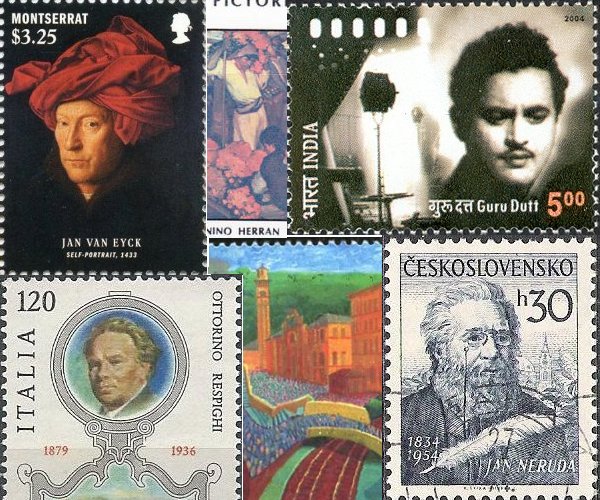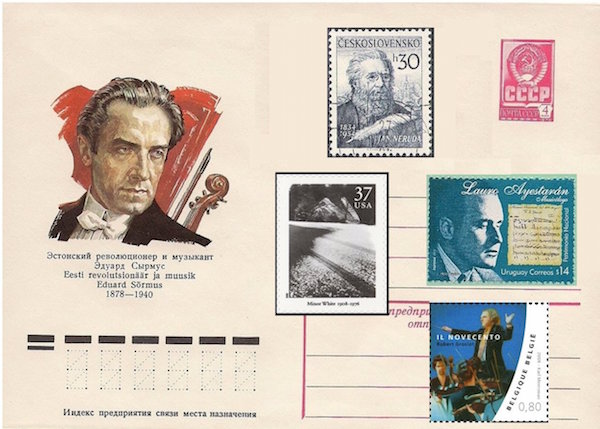The Arts on Stamps of the World — July 9
An Arts Fuse regular feature: the arts on stamps of the world.

By Doug Briscoe
One Old Master and one new one share the spotlight on today’s Arts on Stamps of the World, as Jan van Eyck died on this date in 1441, and David Hockney was born on the same date 496 years later. We also salute the great Indian film director Guru Dutt, beloved American actor Tom Hanks, Italian composer Ottorino Respighi, and a half dozen more.
Jan van Eyck was born some time before 1390 and served as court painter in the Hague and Lille, where Philip the Good, Duke of Burgundy, dealt with the artist open-handedly, allowing him to paint at leisure. From 1429 until the end of his life van Eyck lived in Bruges. Our collage begins with Portrait of a Man, likely a self-portrait, dated 1433. The stamp is from Montserrat. Next to that comes one of van Eyck’s best known works, The Arnolfini Portrait (1434) on a stamp from Ghana. Then we have a U.S. Christmas stamp from 1968 with a detail of the Archangel Gabriel from the Annunciation (1434–36); a Romanian stamp producing a monochrome copy of Portrait of a Man with a Blue Chaperon; and one from Malawi with the Madonna of the Fountain (1439). The second row is given over entirely to details from the Ghent altarpiece (completed 1432). The three Belgian stamps offer us details from the central triptych, while the Maldivian and Rwandan stamps at either side present soldiers of Christ and angel musicians from the side panels. The final row is made up of pieces only attributed to van Eyck: two stamps showing the so-called Ince Hall Madonna (aka Madonna and Child Reading, 1433), Saint Francis of Assisi Receiving the Stigmata (1430-32), and St. Jerome in His Studio (1441).
Stamps displaying the art of David Hockney (born 9 July 1937) seem to be limited to just a single British one showing a detail from his Salts Mill (1994), an 1853 building near Hockney’s home town of Bradford that now houses much of the English painter’s work. In addition to his paintings, prints, and photographs, Hockney has done much work in stage designs for opera, the first being a painted drop for Stravinsky’s The Rake’s Progress at Glyndebourne in 1975. Later projects were for the Royal Opera House, the Metropolitan Opera, and the Chicago Lyric Opera. Boston’s own MFA houses more than a dozen Hockney pieces, including Garrowby Hill (1998).

Guru Dutt, whose birth name was Vasanth Kumar Shivashankar Padukone (9 July 1925 – 10 October 1964), has been hailed as one of the greatest of directors, despite his legacy as an auteur of only eight films. (He acted in about twice as many). His works Pyaasa (1957) and Kaagaz Ke Phool (Paper Flowers, 1959) in particular are held up as belonging on most lists of the greatest films ever made. Ironically, Kaagaz Ke Phool did so poorly at the box office that Dutt’s name appears as director on no further films. He died from an overdose of alcohol and sleeping pills, whether accidentally or intentionally remains unknown. He had made two previous suicide attempts. Dutt began as an actor in 1944, moving on quickly to the position of assistant director. He also choreographed dances for film and took up writing short stories in English. Dutt made his directorial debut with Baazi (Gamble, 1951), a film noir. Though distancing himself from directing credits, he continued acting in film up to the last year of his life.
Of Tom Hanks (born July 9, 1956) little need be said to a contemporary readership. He appears on two African stamps, both of them recalling his performance in Apollo XIII (1995). Hanks had won consecutive Oscars in the two preceding years for Philadelphia and Forrest Gump.
The original works of Ottorino Respighi (1879 – 18 April 1936) include the famous Roman Trilogy (Pines of Rome, Fountains of Rome, Roman Festivals); these and his adaptations of earlier music (The Birds, Ancient Airs and Dances, La boutique fantasque…) are among his most popular creations. Veteran Boston-area radio listeners may recall that two of the movements from the Ancient Airs and Dances Suites were used as the opening themes (on Wednesdays and Thursdays) for Robert J. Lurtsema’s Morning Pro Musica program on WGBH. It was Respighi’s work as a musicologist—he published editions of the works of Monteverdi and Vivaldi—that inspired him to reframe early music in modern orchestral dress. The stamp was issued for his centenary in 1979; the illustration below his portrait is of the Via Appia, reflecting the finale of Pines of Rome: Pines of the Appian Way.

The fine Mexican painter Saturnino Herrán (9 July 1887 – 8 October 1918), who died of tuberculosis at 31, specialized in arresting portrayals of the indigenous people of Mexico, as in Woman of Tehuantepec (1914), La Criolla del Mantón, and the highly evocative Our Ancient Gods (Nuestros dioses antiguos, 1916). Herrán studied art in Mexico City alongside Diego Rivera and, like him, aspired to be a painter of murals. In 1911 he executed a set of these for the School of Arts and Crafts. The stamps show his Self-Portrait, a charcoal sketch dated about 1918, The Offering (La Ofrenda y El jarabe, 1917), and El rebozo (The Shawl, 1916).
Estonian violinist Eduard Sõrmus (Soermus) (July 9, 1878 — August 16, 1940) studied violin in his native Tartu, then (from 1902) at the Saint Petersburg Conservatory under Leopold Auer. His activities in the 1905 Russian Revolution drew the attention of the authorities and led him to flee Russia. This history and his later benefit concerts for labor, the poor, and children earned him the appellation the Red Violinist. There is even a children´s orphanage near Dresden that was built with money from Sõrmus’s concerts. Chagall’s painting Der Geiger was inspired by Sõrmus. Although he has no stamp, a postal card was issued by the USSR in 1978, his centenary year.
Czech writer Jan Neruda (9 July 1834 – 22 August 1891) studied law, philosophy, and philology and worked as a teacher until 1860, when he took up journalism. He had already published a book of pessimistic poems in 1858. His subsequent work was a bit brighter, inspired by his first love, Anna Holinová. For his Czech nationalism Neruda was charged with being a “Traitor of the [Austro-Hungarian] Nation” in 1871, and he forsook his homeland for a time, traveling throughout Europe. He wrote more than 2000 pieces: poems, stories, unsuccessful plays, a novel, feuilletons, notes of travel, art criticism. His love letters to Karolína Světlá provided the basis for the movie Příběh lásky a cti (The Story of Love and Honor, 1977). It is thought that the great Chilean poet Pablo Neruda (neh-RU-da) took his pen name from his Czech predecessor (NEH-ru-da).

American photographer Minor White (July 9, 1908 – June 24, 1976) was nearly thirty before he took up photography, but within a year he had been hired to work on a WPA project in Oregon, and two years later he was teaching the subject. Hiding his homosexuality, as he would do through most of his life, White served as Chief of the Divisional Intelligence Branch in the southern Philippines during World War II. After the war he worked with Alfred Stieglitz in New York and Ansel Adams and Edward Weston in California. White was deeply interested in theory, philosophy, and psychology, investigating such disciplines as the I Ching, Gestalt, astrology, and Zen meditation. In the final years of his life he lived in Arlington, having accepted a position at MIT. On the reverse of the postage stamp, one reads, “White excelled in using symbolic representation, as depicted in Bristol, Vermont, 1971. The arrow on this snowy road represents the concept of passage.”
Uruguayan musicologist Lauro Ayestarán (1913 – 22 July 1966) was born and died in Montevideo. He was on the faculty of the Universidad de la República (UdelaR) and acted as program director of SODRE, the Uruguayan Broadcasting Service. He wrote many books on music, the first being a biography of Domenico Zipoli, an eighteenth-century Italian composer active in Argentina and Paraguay. Later volumes included La primitiva poesía gauchesca en el Uruguay (1950) and La música en el Uruguay (1953).
Robert Groslot (born 9 July 1951) is a Belgian pianist, conductor, and composer. Between 1996 and 2001 he was director of the Royal Conservatory in Antwerp. In 1991 he founded the orchestra Il Novecento. His (and his orchestra’s) stamp is one of ten from the year 2008 celebrating Belgian musicians from various genres.
A graduate of the University of Massachusetts with a B.A. in English, Doug Briscoe worked in Boston classical music radio, at WCRB, WGBH, and WBUR, for about 25 years, beginning in 1977. He has the curious distinction of having succeeded Robert J. Lurtsema twice, first as host of WGBH’s weekday morning classical music program in 1993, then as host of the weekend program when Robert J.’s health failed in 2000. Doug also wrote liner notes for several of the late Gunther Schuller’s GM Recordings releases as well as program notes for the Boston Classical Orchestra. For the past few years he’s been posting a Facebook “blog” of classical music on stamps of the world, which has now been expanded to encompass all the arts for The Arts Fuse.
